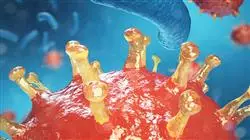University certificate
Scientific endorser

The world's largest faculty of nursing”
Introduction to the Program
An essential Professional master’s degree for Nursing staff that will train them intensively to act in case of infectious diseases, and especially in intervention in case of COVID 19"

In recent years, new infectious diseases have emerged in addition to those already known to specialists. Their care in the hospital emergency setting requires a high level of training on the part of nurses, professionals who are increasingly required to specialize. For this reason, TECH has designed this training of the highest academic level, developed by a team of professionals with extensive experience in both the health and teaching fields.
To this end, TECH has developed a program that includes the classic aspects in the management of infectious pathology by apparatus or organs, obviously taking into account any updates that may have occurred up to the time of the design of this program. In addition, it has incorporated new items, which are essential for the correct management of infectious diseases in the current scenario of health globalization. One of the main novelties of this Professional master’s degree is the specialization in COVID 19, totally new in this educational field and of great value for all professionals who are faced today with the care of patients in the Emergency Department.
The academic program is divided into two main groups: on the one hand, the actions of the healthcare professional in the emergency department in relation to infectious diseases from the point of view of early diagnosis and treatment; and, on the other hand, the concept of risk prevention, derived from the care of infectious diseases, both for healthcare personnel and the population, delving into the measures that can be adopted in the emergency department to minimize them.
In this way, this program is offered as a great value in the education of nurses who develop their work in the field of health emergencies, becoming a preparatory opportunity that should not be missed. In addition, being 100% online, the professional will have the ability to decide when and from where to study, without commitments or obligations, thus being able to combine their study time with the rest of their daily obligations.
Seize the moment and gain up-to-date knowledge on the management of coronavirus infections"
This Professional master’s degree in Infectious Diseases in the Emergency Department for Nursing contains the most complete and up-to-date scientific program on the market. The most important features include:
- The development of more than 75 clinical cases presented by experts in Infectious Diseases in the Emergency Department for Nursing
- The graphic, schematic, and eminently practical contents with which they are created provide scientific and practical information on the disciplines that are essential for professional
- The latest developments in Infectious Diseases
- Practical exercises where to carry out the self-assessment process to improve learning
- An algorithm-based interactive learning system for decision-making in the clinical situations presented throughout the course
- Theoretical lessons, questions to the expert, debate forums on controversial topics, and individual reflection assignments
- Content that is accessible from any fixed or portable device with an Internet connection
Nursing intervention in the care of infectious diseases in the Emergency Department requires very intensive and up-to-date training for the professional. This Professional master’s degree is TECH's quality response to this need”
Its teaching staff includes professionals belonging to the field of Infectious Diseases in the Emergency Department for Nursing, who contribute their work experience to this training, in addition to recognized specialists belonging to leading scientific societies.
The multimedia content, developed with the latest educational technology, will provide the professional with situated and contextual learning, i.e., a simulated environment that will provide an immersive training program designed to train in real situations.
This program is designed around Problem-Based Learning, whereby the professional must try to solve the different professional practice situations that arise during the program. For this purpose, the professional will be assisted by an innovative interactive video system created by renowned and experienced experts in the field of Infectious Diseases with extensive teaching experience.
With this high-level program you will be able to explain epidemic outbreaks and common sources with punctual, continuous, propagative and mixed exposure"

Get to know all the latest information on COVID-19 Don't miss the opportunity to learn about advances in the treatment of infections and incorporate them into your healthcare practice"
Why study at TECH?
TECH is the world’s largest online university. With an impressive catalog of more than 14,000 university programs available in 11 languages, it is positioned as a leader in employability, with a 99% job placement rate. In addition, it relies on an enormous faculty of more than 6,000 professors of the highest international renown.

Study at the world's largest online university and guarantee your professional success. The future starts at TECH”
The world’s best online university according to FORBES
The prestigious Forbes magazine, specialized in business and finance, has highlighted TECH as “the world's best online university” This is what they have recently stated in an article in their digital edition in which they echo the success story of this institution, “thanks to the academic offer it provides, the selection of its teaching staff, and an innovative learning method aimed at educating the professionals of the future”
A revolutionary study method, a cutting-edge faculty and a practical focus: the key to TECH's success.
The most complete study plans on the university scene
TECH offers the most complete study plans on the university scene, with syllabuses that cover fundamental concepts and, at the same time, the main scientific advances in their specific scientific areas. In addition, these programs are continuously being updated to guarantee students the academic vanguard and the most in-demand professional skills. In this way, the university's qualifications provide its graduates with a significant advantage to propel their careers to success.
TECH offers the most comprehensive and intensive study plans on the current university scene.
A world-class teaching staff
TECH's teaching staff is made up of more than 6,000 professors with the highest international recognition. Professors, researchers and top executives of multinational companies, including Isaiah Covington, performance coach of the Boston Celtics; Magda Romanska, principal investigator at Harvard MetaLAB; Ignacio Wistumba, chairman of the department of translational molecular pathology at MD Anderson Cancer Center; and D.W. Pine, creative director of TIME magazine, among others.
Internationally renowned experts, specialized in different branches of Health, Technology, Communication and Business, form part of the TECH faculty.
A unique learning method
TECH is the first university to use Relearning in all its programs. It is the best online learning methodology, accredited with international teaching quality certifications, provided by prestigious educational agencies. In addition, this disruptive educational model is complemented with the “Case Method”, thereby setting up a unique online teaching strategy. Innovative teaching resources are also implemented, including detailed videos, infographics and interactive summaries.
TECH combines Relearning and the Case Method in all its university programs to guarantee excellent theoretical and practical learning, studying whenever and wherever you want.
The world's largest online university
TECH is the world’s largest online university. We are the largest educational institution, with the best and widest online educational catalog, one hundred percent online and covering the vast majority of areas of knowledge. We offer a large selection of our own degrees and accredited online undergraduate and postgraduate degrees. In total, more than 14,000 university degrees, in eleven different languages, make us the largest educational largest in the world.
TECH has the world's most extensive catalog of academic and official programs, available in more than 11 languages.
Google Premier Partner
The American technology giant has awarded TECH the Google Google Premier Partner badge. This award, which is only available to 3% of the world's companies, highlights the efficient, flexible and tailored experience that this university provides to students. The recognition as a Google Premier Partner not only accredits the maximum rigor, performance and investment in TECH's digital infrastructures, but also places this university as one of the world's leading technology companies.
Google has positioned TECH in the top 3% of the world's most important technology companies by awarding it its Google Premier Partner badge.
The official online university of the NBA
TECH is the official online university of the NBA. Thanks to our agreement with the biggest league in basketball, we offer our students exclusive university programs, as well as a wide variety of educational resources focused on the business of the league and other areas of the sports industry. Each program is made up of a uniquely designed syllabus and features exceptional guest hosts: professionals with a distinguished sports background who will offer their expertise on the most relevant topics.
TECH has been selected by the NBA, the world's top basketball league, as its official online university.
The top-rated university by its students
Students have positioned TECH as the world's top-rated university on the main review websites, with a highest rating of 4.9 out of 5, obtained from more than 1,000 reviews. These results consolidate TECH as the benchmark university institution at an international level, reflecting the excellence and positive impact of its educational model.” reflecting the excellence and positive impact of its educational model.”
TECH is the world’s top-rated university by its students.
Leaders in employability
TECH has managed to become the leading university in employability. 99% of its students obtain jobs in the academic field they have studied, within one year of completing any of the university's programs. A similar number achieve immediate career enhancement. All this thanks to a study methodology that bases its effectiveness on the acquisition of practical skills, which are absolutely necessary for professional development.
99% of TECH graduates find a job within a year of completing their studies.
Professional Master's Degree in Infectious Diseases in the Emergency Department for Nurses
In recent years, new infectious diseases have emerged in addition to those already known, and their care in the hospital emergency setting requires a great deal of preparation on the part of nurses. In order to meet this need, TECH has created a Professional Master's Degree in Infectious Diseases in the Emergency Department for Nursing of high academic quality. Designed by a team of professionals with extensive experience in the health sector and teaching, it addresses the classic management of infectious pathology by devices or organs, updated to the latest developments in this field.
Position yourself as a reference in assisting the infectious pathology patient.
This Professional Master's Degree in Infectious Diseases in the Emergency Department for Nursing includes essential strategies in the management of infectious diseases in the current context of globalization of Health, such as specialization in COVID-19. Undoubtedly, this provides added value to the Professional Master's Degree. You will also be updated in the prevention of risks derived from the care of infectious diseases, both for health personnel and for the general population. All this in an online academic course of 1,500 hours in which you will consult dynamic interactive schemes, videos, self-assessment exercises, master classes and much more.







